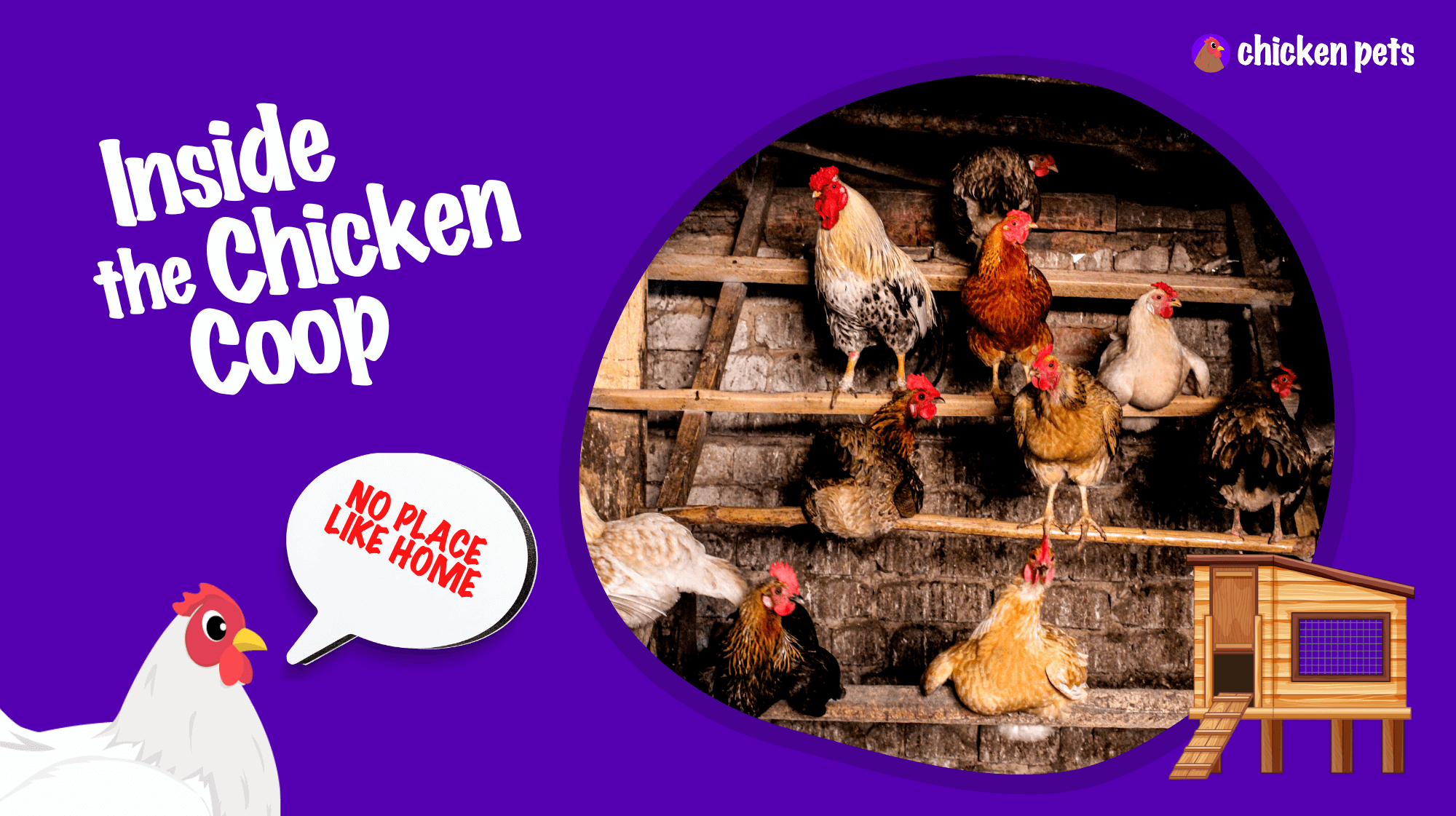Are you ready for a tour of the most luxe chicken real estate on the block? Welcome to the chicken coop edition of Cribs! We’re gonna take you inside the finest feathered abodes, where the roost is the absolute boss. So sit back, grab a feather duster, and let’s get clucking!
If you’re planning on keeping chickens, you’ll need a place for them to call home. The coop is where your birds will sleep, lay their eggs, and take shelter from the elements. Certain things should be inside the chicken coop to ensure your birds are happy, healthy, and safe. This blog post will discuss what you need to ensure your chicken coop has everything your birds need.
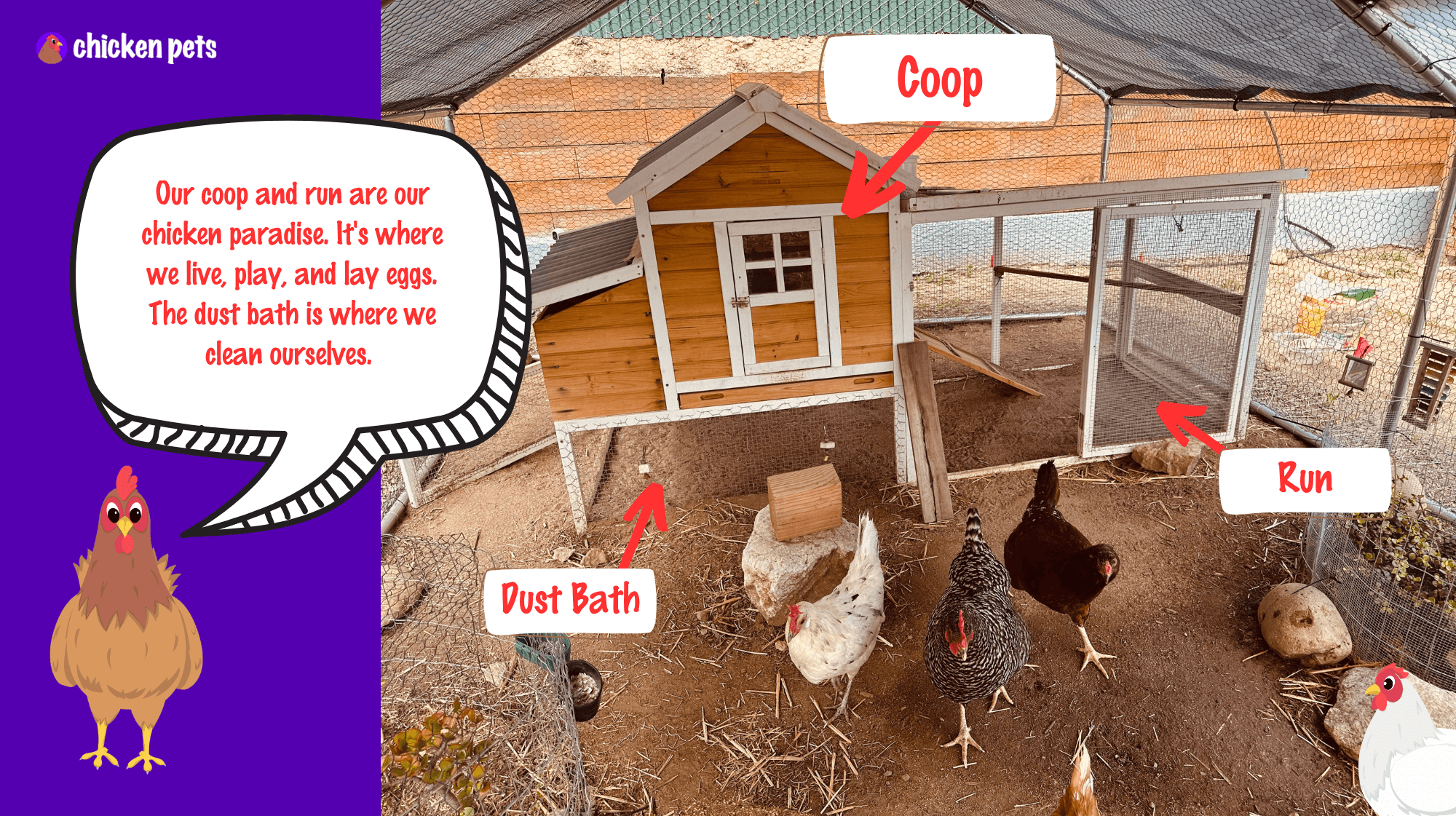
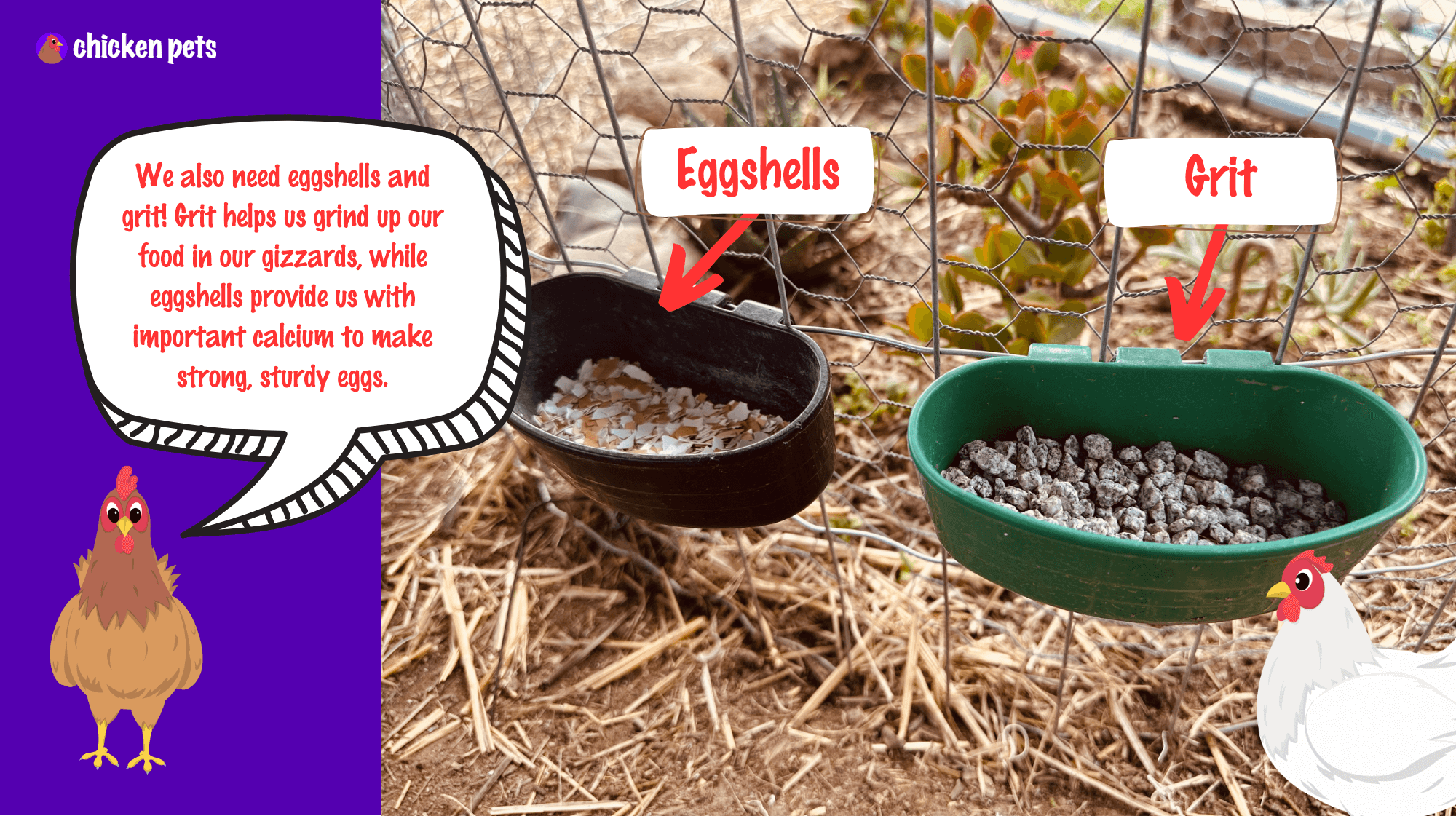

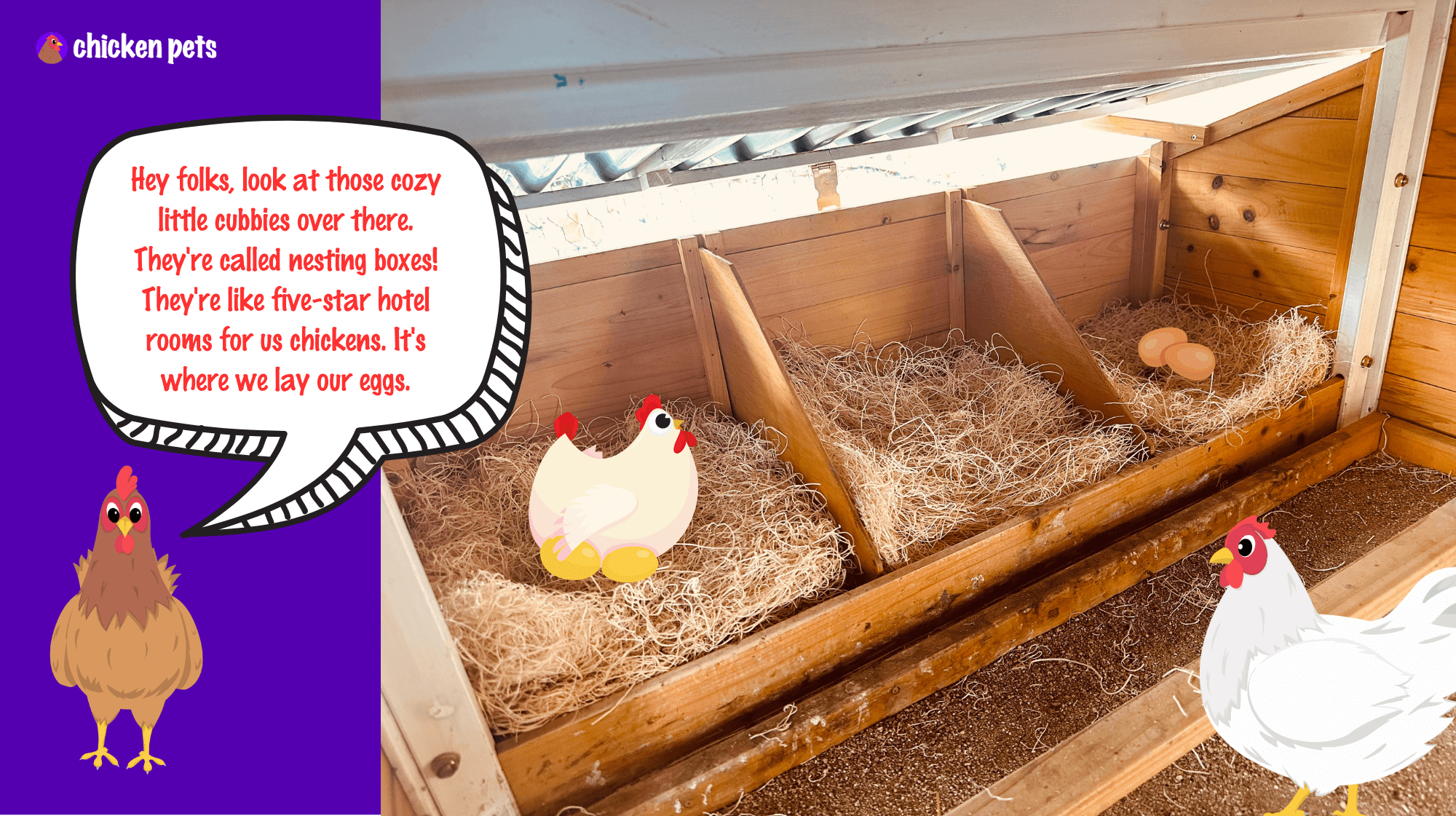

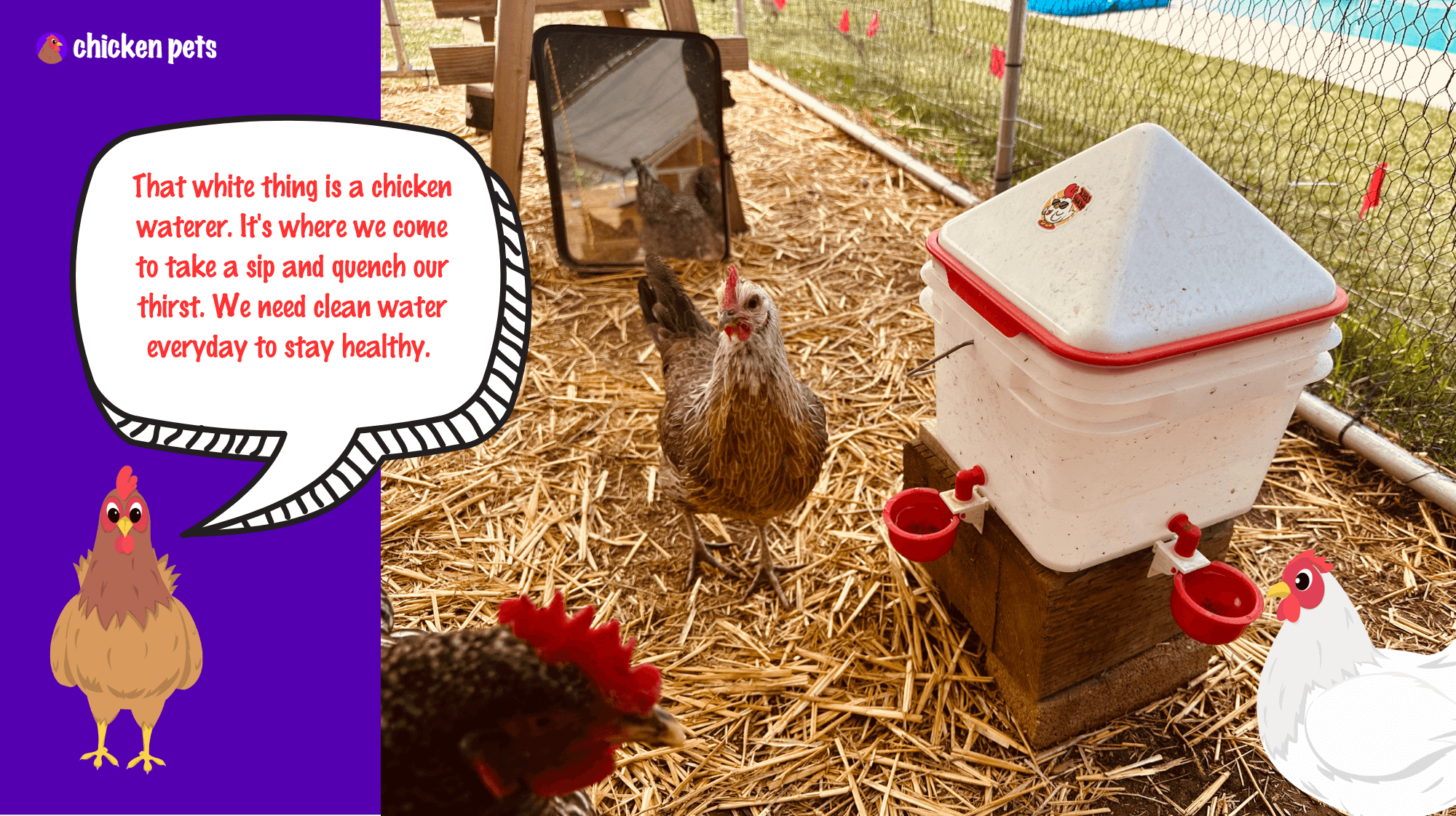
What should be inside a chicken coop?
- Nesting boxes — Chickens lay eggs in a secure, quiet place, so provide them with nesting boxes. One box per 4-5 hens is enough.
- Roosting bars — Chickens sleep on roosting bars, so make sure your coop has enough bars for all your birds.
- Ventilation — Chickens need fresh air, so the coop should be well-ventilated. Make sure there are windows or vents to allow for proper air circulation.
- Insulation — Chickens need to stay warm in the winter, so ensure the coop is well-insulated. Add insulation to the walls, roof, and floor to warm the coop.
- Lighting — Chickens need light to lay eggs, so ensure the coop has enough light. You can use natural or artificial lighting to give the birds enough light to see.
- Cleanable flooring — Chickens can be messy, so make sure the coop floor is easy to clean. Consider using a material like concrete or linoleum that can be easily sanitized.
- Easy-to-clean manure management system — Chickens produce a lot of manure, so make sure you have the plan to manage it. You can use a compost bin or a litter box, but ensure it’s easy to clean and doesn’t attract pests.
- Access door for humans — You’ll need to be able to get into the coop to clean it, collect eggs, and check on the birds, so make sure there’s a door that you can easily access.
- Protection from predators — Ensure the coop is protected from predators like foxes, raccoons, and snakes. Consider using hardware cloth or chicken wire to keep your birds safe.
- Adequate space per bird — Chickens need enough space to move around and spread their wings, so make sure the coop is big enough for all your birds. A general rule of thumb is 4 square feet per bird.
See also: Omlet Chicken Coop Eglu Cube Review – This is an excellent starter chicken coop for beginner farmers.
Additional considerations for your chicken coop.
While the above items are essential for any chicken coop, there are a few other things you may want to consider to make your coop even better.
- Feeders — Chickens need a place to eat, so make sure you have feeders in the coop. You can use traditional or hanging feeders to keep food off the ground.
- Waterers — Chickens need access to clean water, so make sure you have waterers in the coop. You can use a traditional or nipple waterer to keep the water clean and prevent spillage.
- Dust bathing area — Chickens love to take dust baths, so please ensure there’s an area in the coop where they can do this. Fill a shallow container with sand or dust, and place it in the corner of the coop.
- Pest control measures — Pests like mice and insects can be a problem in chicken coops, so ensure you have steps to control them. Natural pest control methods like diatomaceous earth, essential oils, or chemical pest control products can be used.
- Natural light or artificial lighting for winter months — Chickens need light to lay eggs, and they may not get enough natural light during winter. Consider adding artificial lighting to the coop to ensure the birds have enough light.
- A run or outdoor area for the birds to forage — Chickens love to forage, so ensure they have access to an outdoor space where they can do this. You can use a run or a fenced-in area to keep the birds safe.
- Litter material for bedding — Chickens need a soft place to sleep, so make sure you have bedding in the coop. You can use materials like straw, pine shavings, or leaves to create a soft, comfortable place for the birds to sleep.
- Perches — Chickens like to roost at night, so make sure there are perches in the coop. You can use branches or wooden dowels for perches.
- Weather protection — Chickens need protection from the elements, so make sure the coop is weather-proof. Consider adding a roof to the coop or installing windows to keep the birds dry and warm.
These are just a few additional items to consider when building or setting up your chicken coop. If you take the time to view these items, you’ll have a coop that meets your birds’ basic needs and provides them with a comfortable and safe environment.
Inside the chicken coop FAQ.
Chicken coops are essential to backyard chicken keeping, providing a safe and comfortable home for your feathered friends. We compiled a list of the most frequently asked questions that people ask about what should be inside a chicken coop.
What do you put on the inside of a chicken coop?
A chicken coop should be outfitted with various items to ensure the health and safety of the chickens. This includes a roosting bar, nesting boxes, bedding material such as straw or wood shavings, feeders, waterers, and a dust bath. The roosting bar should be placed high enough off the ground to allow the chickens to perch comfortably. The nesting boxes should be placed in a quiet corner of the coop and filled with a soft material such as straw or wood shavings. Feeders and waterers should be placed conveniently for the chickens to access. Finally, You should provide a dust bath for the chickens to bathe in and keep their feathers clean.
What is the best thing to put in a chicken coop?
A chicken coop should include various items to ensure the health and safety of the chickens. The essentials are a secure shelter, a nesting box, perches, feeders, waterers, and bedding. The shelter should be well-ventilated and protected from the elements, predators, and other animals. The nesting box should be large enough for all chickens to lay eggs in and be kept clean. You should provide perches for the chickens to roost on and place them at different heights to offer variety. Feeders and waterers should be placed in the coop and cleaned regularly. Finally, bedding should be provided to keep the coop warm and comfortable and be changed periodically.
What is the best thing to put in the bottom of a chicken coop?
The best thing to put in the bottom of a chicken coop is a layer of bedding. Bedding material should be absorbent, dust-free, and non-toxic. Popular choices for bedding material include straw, wood shavings, shredded paper, and shredded cardboard. You should change the bedding regularly to keep the coop clean and dry and prevent the spreading bacteria and parasites. Additionally, the bedding should be deep enough to provide cushioning and insulation for the chickens. Finally, the bedding should be kept dry, as wet bedding can lead to mold, bacteria, and other health issues for the chickens.
What should I make the floor of my chicken coop out of?
When building a chicken coop, the floor should be constructed with a material that is durable, easy to clean, and non-toxic. Concrete, wood, and hardware cloth are the most common materials for chicken coop floors. Concrete is the most durable option, but it can be expensive and difficult to install. Wood is an affordable and easy-to-install option, but it needs to be treated to prevent rot and pests. Hardware cloth is a good option for a floor because it is easy to clean and provides good ventilation. However, it can be challenging to install and may require additional support. Ultimately, the best flooring option for a chicken coop depends on the individual needs of the backyard chicken owner.
Should I use hay or straw in my chicken coop?
Using hay or straw in your chicken coop is a personal preference. Hay is typically more expensive than straw, but it is absorbent and can provide more insulation. Straw is a good choice for bedding because it is more affordable and provides cushioning for your chickens. It is important to remember that You should change hay and straw regularly to prevent the spreading of disease and parasites. Additionally, hay and straw should be kept dry to avoid mold and mildew growth. Ultimately, the choice of hay or straw for your chicken coop depends on your budget and the needs of your chickens.
Should I put wood chips in my chicken coop?
Using wood chips in your chicken coop can be beneficial for various reasons. Wood chips help to absorb moisture, reduce odor, and provide insulation. Additionally, wood chips can provide a comfortable and safe environment for your chickens to scratch and forage. When using wood chips, it is vital to use a safe type of wood, such as cedar or pine, and to change the chips regularly to prevent the buildup of bacteria and parasites. Additionally, it is vital to ensure the wood chips are not too deep, as this can make it difficult for your chickens to move around. Finally, ensuring that the wood chips are not too close to the coop’s walls is essential, as this can create a fire hazard.
What do chickens need the most?
Chickens need a safe, secure environment with adequate shelter, food, and water. They need a balanced diet of grains, greens, and protein and access to grit and oyster shells for digestion. They need access to clean, fresh water and a hygienic dust bath. They need plenty of space to roam, scratch, and forage and a place to lay eggs. They need to be protected from predators and extreme weather conditions. Finally, they require regular veterinary care and vaccinations to stay healthy.
How do I attract bugs to my chicken coop?
Attracting bugs to your chicken coop is vital in providing your chickens with a healthy diet. To do this, you can start by providing a variety of food sources such as grains, fruits, and vegetables. You can also add a shallow water dish to your coop to attract bugs. Additionally, you can set up a compost pile near the coop to provide a food source for bugs. Finally, you can introduce beneficial insects such as ladybugs, lacewings, and praying mantises to your coop to help control pests and provide a food source for your chickens.
What keeps chicken coops from smelling?
You can keep a chicken coop from smelling by regularly cleaning the coop, providing adequate ventilation, and using absorbent bedding materials. Cleaning the coop should include removing soiled bedding, droppings, and food scraps. Ventilation can be achieved by installing windows and vents and ensuring the coop is well-insulated. Bedding materials such as wood shavings, straw, or shredded paper can help absorb moisture and odors. Additionally, adding a few handfuls of food-grade diatomaceous earth to the bedding can help absorb odors and reduce the presence of parasites. Finally, adding a few plants to the coop can help absorb odors and provide a natural air freshener.
How often do you change wood shavings in a chicken coop?
It is recommended that wood shavings in a chicken coop be changed out every 1-3 months. This is to ensure that the chickens have a clean and comfortable environment. Removing wet or soiled bedding is essential, as this can lead to ammonia buildup and an unhealthy environment for the chickens. It is also vital to check the bedding for parasites and pests and replace the bedding if any are found. Cleaning the coop and changing the bedding can help to keep the chickens healthy and happy.
Is sand or wood chips better for a chicken run?
Sand and wood chips are both suitable materials for a chicken run. Sand is easy to clean and provides good drainage, but it can be dusty and difficult to keep dry. Wood chips are absorbent and provide good insulation, but they can be more challenging to clean and may need to be replaced more often. Ultimately, the best material for a chicken run depends on the individual needs of the backyard chicken owner. Consider the run size, the climate, the number of chickens, and the time available for maintenance when deciding which material is best.
What is the best flooring for a chicken run?
The best flooring for a chicken run is a combination of grass and gravel. Grass provides chickens with a natural environment to forage, while gravel helps to keep the run dry and free of mud. Additionally, gravel helps reduce the spread of parasites and diseases. You can also use it to create dust baths for chickens. To ensure the health and safety of your chickens, it is essential to keep the run clean and free of debris. If you use grass, mow it regularly and keep it free of weeds. It is also necessary to keep the run well-drained and use a deep layer of gravel to help prevent flooding.
How often do you clean chicken run?
A chicken run should be cleaned regularly every 1-2 weeks. This will help to keep the chickens healthy and prevent the spread of disease. To clean the run, remove droppings, feathers, and other debris. Next, scrub down the walls and floor of the run with mild detergent and warm water. Rinse the run with clean water and allow it to dry completely before adding fresh bedding. Finally, make sure to disinfect the run with a poultry-safe disinfectant. This will help to kill any bacteria or parasites that may be present.
Should I put straw on the floor of my chicken coop?
Using a straw to line the floor of a chicken coop is a popular choice for many backyard chicken owners. Straw is absorbent, which helps keep the coop dry and free of odors. It also provides insulation, helping to support the coop warm in the winter and cool in the summer. Additionally, straw offers a comfortable surface for chickens to walk on and can help reduce the spread of disease. However, straw must be changed regularly to prevent the buildup of bacteria, and it can attract rodents and other pests if not appropriately managed. Therefore, it is essential to weigh the pros and cons of using a straw when deciding whether or not to line the floor of your chicken coop.
Is a dirt floor OK for a chicken coop?
A dirt floor in a chicken coop can be suitable for backyard chickens, although there are some potential drawbacks. For example, a dirt floor can become muddy when wet, which can be uncomfortable for chickens and lead to health issues. Additionally, a dirt floor can be challenging to clean and attract pests. However, a dirt floor can be beneficial because it absorbs moisture and provides insulation. To ensure the health and safety of your chickens, it is essential to regularly check the dirt floor’s condition and take measures to reduce the risk of pests. Additionally, it is necessary to provide adequate bedding material to keep the chickens comfortable and healthy.
Should chicken food be in the coop or run?
The best practice for feeding chickens is to provide food in both the coop and the run. In the coop, you should place food in a feeder that is off the ground and out of the reach of other animals, and this will prevent contamination and keep the food dry. In the run, food should be placed in a feeder accessible to the chickens but out of the reach of other animals. It should also be placed in a sheltered spot from the elements. Both feeders should be filled with high-quality feed appropriate for the chickens’ age and breed. Additionally, it is essential to provide a source of fresh, clean water in both the coop and the run.
How do you winterize a chicken coop?
Winterizing a chicken coop involves several steps to ensure the chickens are safe and healthy during the cold winter:
- The coop should be thoroughly cleaned and disinfected.
- The coop should be well-insulated, with extra bedding added to the floor and walls. The coop should also be well-ventilated, with an appropriate number of windows and vents.
- The coop should be protected from drafts and moisture by caulking around the windows and doors.
- The chickens should be provided with a heat source, such as a heat lamp, to keep them warm and comfortable.
Are grass clippings good for chicken coops?
Grass clippings can be beneficial for chicken coops in certain circumstances. They can provide a source of additional nutrition for chickens, as they contain nitrogen and other minerals. Additionally, grass clippings can help to keep the coop floor dry and absorb odors. However, grass clippings should not be used if treated with any chemicals, such as fertilizers or pesticides, as these can be toxic to chickens. Additionally, grass clippings should be used in moderation, as too much can lead to a buildup of ammonia, harming chickens. Finally, it is crucial to ensure that the grass clippings are not moldy or contaminated with any other toxins, as these can also be harmful to chickens.
What shavings are best for chickens?
The best chicken shavings are made from softwood, such as pine or cedar. Softwood shavings are absorbent, dust-free, and provide insulation for chickens. Cedar shavings are perfect for chickens, as they naturally resist mites and other pests. However, softwood shavings should be used in moderation, as they can be abrasive and cause respiratory issues. Aspen shavings are also a good option, as they are dust-free and absorbent. Straw is not recommended, as it can be dusty and harbor mites and other pests. Backyard chicken owners should also avoid using sawdust, as it can be challenging to clean and cause respiratory issues.
What foods are toxic to chickens?
Chickens should not be fed toxic foods, which can be dangerous and even fatal. Foods that are toxic to chickens include chocolate, avocado, caffeine, alcohol, raw potatoes, raw beans, raw egg whites, raw fish, and moldy or spoiled food. Additionally, onions, garlic, and rhubarb can be toxic in large quantities. You should avoid citrus fruits as they can cause digestive issues. Finally, it is essential to note that many human foods, such as candy, chips, and processed foods, are unsuitable for chickens and should be avoided.
What food do chickens love the most?
Chickens love a variety of foods, including grains, fruits, vegetables, and insects. Grains such as corn, wheat, and oats are a great source of energy for chickens and should be included in their diet. Fruits and vegetables, such as apples, carrots, and greens, provide essential vitamins and minerals. Insects, such as mealworms, crickets, and earthworms, are a great source of protein and should be offered to chickens regularly. Additionally, chickens love treats such as yogurt, cooked eggs, and mealworms. It is essential to provide a balanced diet for chickens, including various foods, to ensure they remain healthy and happy.
What is poisonous to chickens?
Various substances, including certain plants, foods, and chemicals, can poison chickens. Common plants that are toxic to chickens include foxglove, lily of the valley, oleander, and yew. Foods such as chocolate, avocado, and onions can also poison chickens. Additionally, pesticides, herbicides, and rodenticides can be toxic to chickens if ingested. Backyard chicken owners need to be aware of these potential hazards and take steps to keep their chickens safe.
How do I protect the inside of my chicken coop?
Protecting the inside of your chicken coop involves taking several steps to ensure the safety and health of your chickens:
- Make sure to keep the cage clean and free of debris. Remove any old bedding and replace it with fresh, clean bedding.
- Ensure the cage is well-ventilated and has enough space for the chickens to move around.
- Please make sure to keep the pen secure from predators. Install a secure door and use hardware cloth to cover windows or openings.
- Use a pest control program to support the coop free of bugs and rodents.
Please regularly look over the coop for signs of pests and take appropriate action to ensure they are taken care of. Following these steps will help protect the inside of your chicken coop.
What do you put in a chicken coop for bedding?
For bedding in a chicken coop, backyard chicken owners should use materials such as straw, wood shavings, hay, shredded paper, or shredded cardboard. These materials should be dry, clean, and free of dust, mold, and other contaminants. Additionally, You should change the bedding regularly to ensure the chickens stay healthy and comfortable. The bedding should be deep enough to allow the chickens to scratch and forage and be kept dry to reduce the disease risk. Finally, the bedding should be replaced every few months to ensure the chickens have a clean and comfortable environment.
What is the best winter bedding for chickens?
The best winter bedding for chickens is a combination of straw, wood shavings, and hay. Straw is an excellent insulator and helps keep chickens warm in cold temperatures. Wood shavings provide a comfortable and absorbent surface for chickens to sleep on. Hay can help to keep the bedding dry and free of moisture, which helps to keep chickens healthy. Additionally, grass can provide a source of extra nutrition for chickens during the winter months. All of these materials should be kept dry and changed regularly to ensure the health and comfort of chickens during the winter months.
How do you keep the inside of a chicken coop clean?
To clean the inside of a chicken coop, it is important to regularly remove and dispose of chicken droppings, bedding, and other debris. Additionally, it is essential to clean and disinfect the coop and its fixtures, such as feeders and waterers, regularly. This can be done by scrubbing the surfaces with a brush and a mild detergent and then rinsing and drying them. Furthermore, keeping the coop well-ventilated and dry is essential, as this will help reduce the buildup of bacteria and odors. Finally, it is necessary to regularly check for signs of pests, such as mites and rats, and take appropriate action if any are found.
What kills odor in a chicken coop?
Odor in a chicken coop can be eliminated by regularly cleaning the coop and removing any droppings, feathers, and other debris. Additionally, adding a bedding layer such as straw or wood shavings can help absorb moisture and odors. To further reduce odors, use a fan to circulate fresh air and keep the coop well-ventilated. Finally, adding a natural odor absorber such as baking soda, activated charcoal, or diatomaceous earth can help reduce odors and keep the coop smelling fresh.
Can I spray vinegar in the chicken coop?
It is generally not recommended to spray vinegar in a chicken coop due to the potential for respiratory irritation and other health risks. Vinegar is acidic and can potentially burn chickens’ eyes, skin, and respiratory tract. Additionally, vinegar can damage the wood and other materials used to build the coop. To clean and disinfect the coop, it is best to use a cleaner specifically designed for chicken coops, such as a mild detergent and water solution. Additionally, it is essential to regularly clean the coop to prevent the buildup of bacteria, viruses, and other pathogens that can cause disease in chickens.
How often should a chicken coop be cleaned?
A chicken coop should be cleaned regularly, typically at least once a month. This should include removing wet or soiled bedding, cleaning and disinfecting the coop, and replacing the bedding with fresh material. Also, the coop should be inspected for any signs of damage or pests, and necessary repairs should be made. Finally, the coop should be checked for adequate ventilation, and the nesting boxes should be cleaned and refilled with fresh bedding.
How often should you change shavings in the chicken coop?
It is recommended that backyard chicken owners change the shavings in their chicken coop every two to three months. This ensures that the coop remains clean and free of bacteria and parasites. During the changing process, the coop should be thoroughly cleaned and disinfected to prevent the spread of disease. The shavings should be replaced entirely, not just added to the existing ones. Before adding them to the coop, it is also essential to check the shavings for signs of mold or other contaminants. Additionally, the shavings should be checked for moisture levels and changed if they become too wet. Finally, the shavings should be changed more frequently in the summer months to prevent the buildup of heat and humidity in the coop.
What do backyard chickens need in the winter?
Backyard chickens need adequate shelter, food, and water during winter. The shelter should be well-ventilated and draft-free, with enough space for the chickens to move around and roost. The floor should be covered with a thick layer of bedding, such as straw or wood shavings, to keep the chickens warm and dry. Food should be provided in a hopper-style feeder to keep it dry and free from contamination. The feed should be high-quality and provide enough protein and energy to keep chickens healthy and active. Water should be provided in a heated container, such as a heated water bowl, to prevent freezing. Additionally, chickens should be monitored for signs of illness and provided with extra bedding and food.
What do you put in a chicken coop for winter?
To prepare a chicken coop for winter, a backyard chicken owner should provide adequate insulation, ventilation, and protection from the elements. Insulation can be achieved by adding extra bedding, such as straw or wood shavings, to keep the coop warm. Ventilation is essential to prevent moisture buildup and reduce the risk of respiratory illnesses. Protection from the elements can be provided by adding a windbreak or covering the coop with plastic sheeting. Additionally, the coop should be cleaned regularly, and the chickens should have access to food and water. Finally, a heat lamp may be necessary for frigid climates.
What kills chickens in the coop at night?
Various predators can kill chickens in the coop at night, including foxes, raccoons, skunks, weasels, hawks, owls, and snakes. To protect chickens from these predators, it is crucial to ensure the coop is secure and well-maintained. This includes ensuring that the coop is made of sturdy materials, such as metal or wood, and that the walls and roof are in good condition. The coop should be kept clean and free of debris, and the entrance should be covered with a secure door or window. Finally, checking the coop regularly for signs of predators, such as tracks, droppings, or feathers, is essential.
What is the best floor for the chicken run?
The best floor for a chicken run is easy to clean, provides good drainage, and is comfortable for the chickens. A good option is a floor made of gravel, which is easy to clean and provides good drainage. Additionally, it is comfortable for the chickens to walk on and can help keep their feet healthy. Another option is a wood chips floor, which is easy to clean and provides good drainage. It is also comfortable for the chickens to walk on and can help keep their feet healthy. Finally, a floor made of sand is also an option, as it is easy to clean and provides good drainage. However, it is less comfortable for the chickens to walk on and can be harder to keep clean.
What keeps rats out of a chicken coop?
It is essential to take preventative measures to keep rats out of a chicken coop. This includes sealing any holes or gaps in the coop walls and foundation, keeping the coop clean and free of food scraps, and regularly inspecting the coop for signs of rat activity. Additionally, it is essential to ensure that the coop is well-ventilated and that the chickens have access to fresh water and feed. Finally, it is recommended to use a rat-proof feeder and to place traps around the coop to catch any rats that may have already entered. By following these steps, backyard chicken owners can help ensure that their coop remains rat-free.

